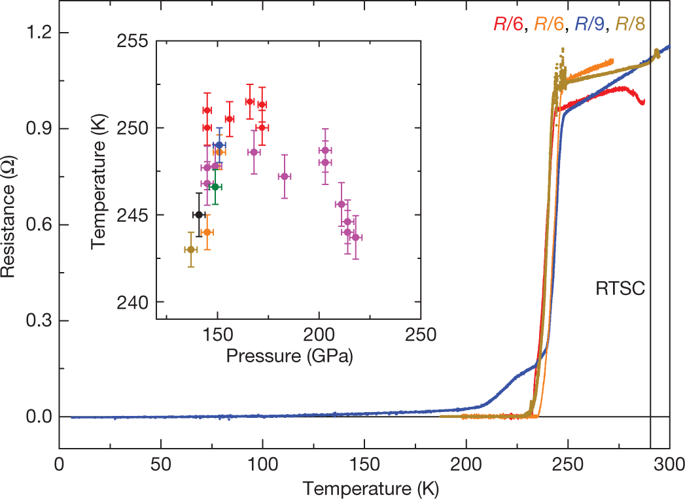Our official English website, www.x-mol.net, welcomes your
feedback! (Note: you will need to create a separate account there.)
Superconductivity at 250 K in lanthanum hydride under high pressures
Nature ( IF 50.5 ) Pub Date : 2019-05-01 , DOI: 10.1038/s41586-019-1201-8 A P Drozdov 1 , P P Kong 1 , V S Minkov 1 , S P Besedin 1 , M A Kuzovnikov 1, 2 , S Mozaffari 3 , L Balicas 3 , F F Balakirev 4 , D E Graf 3 , V B Prakapenka 5 , E Greenberg 5 , D A Knyazev 1 , M Tkacz 6 , M I Eremets 1
Nature ( IF 50.5 ) Pub Date : 2019-05-01 , DOI: 10.1038/s41586-019-1201-8 A P Drozdov 1 , P P Kong 1 , V S Minkov 1 , S P Besedin 1 , M A Kuzovnikov 1, 2 , S Mozaffari 3 , L Balicas 3 , F F Balakirev 4 , D E Graf 3 , V B Prakapenka 5 , E Greenberg 5 , D A Knyazev 1 , M Tkacz 6 , M I Eremets 1
Affiliation

|
With the discovery1 of superconductivity at 203 kelvin in H3S, attention returned to conventional superconductors with properties that can be described by the Bardeen–Cooper–Schrieffer and the Migdal–Eliashberg theories. Although these theories predict the possibility of room-temperature superconductivity in metals that have certain favourable properties—such as lattice vibrations at high frequencies—they are not sufficient to guide the design or predict the properties of new superconducting materials. First-principles calculations based on density functional theory have enabled such predictions, and have suggested a new family of superconducting hydrides that possess a clathrate-like structure in which the host atom (calcium, yttrium, lanthanum) is at the centre of a cage formed by hydrogen atoms2–4. For LaH10 and YH10, the onset of superconductivity is predicted to occur at critical temperatures between 240 and 320 kelvin at megabar pressures3–6. Here we report superconductivity with a critical temperature of around 250 kelvin within the $$Fm\bar{{\bf{3}}}m$$Fm3¯m structure of LaH10 at a pressure of about 170 gigapascals. This is, to our knowledge, the highest critical temperature that has been confirmed so far in a superconducting material. Superconductivity was evidenced by the observation of zero resistance, an isotope effect, and a decrease in critical temperature under an external magnetic field, which suggested an upper critical magnetic field of about 136 tesla at zero temperature. The increase of around 50 kelvin compared with the previous highest critical temperature1 is an encouraging step towards the goal of achieving room-temperature superconductivity in the near future.A lanthanum hydride compound at a pressure of around 170 gigapascals is found to exhibit superconductivity with a critical temperature of 250 kelvin.
中文翻译:

高压下氢化镧中 250 K 的超导性
随着 H3S 中 203 开尔文的超导性的发现,人们的注意力又回到了传统的超导体上,这些超导体的特性可以用 Bardeen-Cooper-Schrieffer 和 Migdal-Eliashberg 理论来描述。尽管这些理论预测了具有某些有利特性(例如高频下的晶格振动)的金属具有室温超导性的可能性,但它们不足以指导设计或预测新超导材料的特性。基于密度泛函理论的第一性原理计算已经实现了这样的预测,并提出了一个新的超导氢化物家族,它们具有笼状结构,其中主体原子(钙、钇、镧)位于形成的笼子的中心由氢原子2-4。对于 LaH10 和 YH10,预计超导的开始发生在 240 到 320 开尔文之间的临界温度和兆巴压力3-6。在这里,我们报告了在约 170 吉帕的压力下,LaH10 的 $$Fm\bar{{\bf{3}}}m$$Fm3¯m 结构内临界温度约为 250 开尔文的超导性。据我们所知,这是迄今为止在超导材料中确认的最高临界温度。零电阻、同位素效应和在外部磁场下临界温度的降低证明了超导性,这表明在零温度下的上临界磁场约为 136 特斯拉。
更新日期:2019-05-01
中文翻译:

高压下氢化镧中 250 K 的超导性
随着 H3S 中 203 开尔文的超导性的发现,人们的注意力又回到了传统的超导体上,这些超导体的特性可以用 Bardeen-Cooper-Schrieffer 和 Migdal-Eliashberg 理论来描述。尽管这些理论预测了具有某些有利特性(例如高频下的晶格振动)的金属具有室温超导性的可能性,但它们不足以指导设计或预测新超导材料的特性。基于密度泛函理论的第一性原理计算已经实现了这样的预测,并提出了一个新的超导氢化物家族,它们具有笼状结构,其中主体原子(钙、钇、镧)位于形成的笼子的中心由氢原子2-4。对于 LaH10 和 YH10,预计超导的开始发生在 240 到 320 开尔文之间的临界温度和兆巴压力3-6。在这里,我们报告了在约 170 吉帕的压力下,LaH10 的 $$Fm\bar{{\bf{3}}}m$$Fm3¯m 结构内临界温度约为 250 开尔文的超导性。据我们所知,这是迄今为止在超导材料中确认的最高临界温度。零电阻、同位素效应和在外部磁场下临界温度的降低证明了超导性,这表明在零温度下的上临界磁场约为 136 特斯拉。











































 京公网安备 11010802027423号
京公网安备 11010802027423号